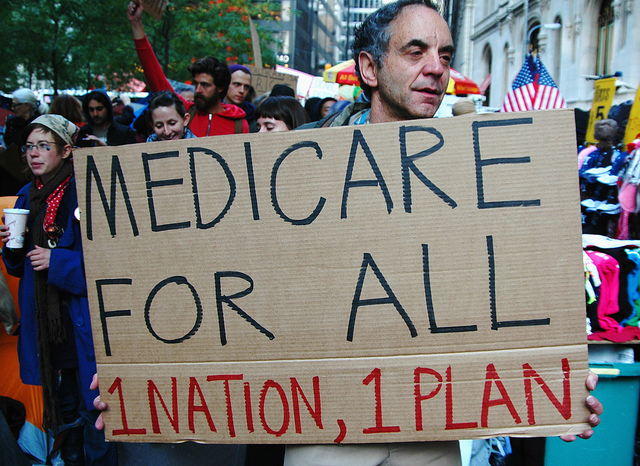Updated: Healthy California, a bill passed by the California Senate but now put on hold by the Assembly, could pave the way for improved Medicare for all. It guarantees every California resident all the benefits of Medicare and a lot more, with no premiums, deductibles or coinsurance. It’s genius is its simplicity, efficiency and equity.
How would Healthy California work? All California residents (regardless of immigration status) would be covered for care from virtually any doctor or hospital in the state. If they preferred, they could enroll in an integrated care plan, like Kaiser. And, they would pay no premium, deductible or copay for this coverage.
What services would Healthy California cover? It would cover all essential medical and hospital services, durable medical equipment, prescription drugs, dental, vision and hearing, as well the development of plan to cover nursing home care and other long-term services and supports. [see note 1 below]
What if you have Medicare? You would continue to be able to get care from the doctors and hospitals of your choice, but you would stop paying a Medicare premium, deductible and coinsurance. You would no longer need to choose a Part D drug plan or have Medicare supplemental insurance. All your medically reasonable and necessary care, medical equipment and prescription drugs would be covered in full. Everyone would be insured and those currently underinsured (i.e. those with high copays and deductibles) would now have full universal coverage.
How is Healthy California funded? The legislation is silent. But a new financial analysis by economists at the Political Economy Research Institute at UMass, (PERI), proposes this: Public funds (e.g. Medicare and Medicaid) that already pay more than 70 percent of all health care expenditures in California would now flow into a single payer pool. In addition, anyone buying goods or services in California would pay a 2.3 percent dedicated sales tax, with exemptions for necessities such as housing, utilities, food at home and other low income rebates to promote tax equity. Businesses would also pay a 2.3 percent gross receipts tax on all revenue over $2 million. Thus, 80 percent of businesses in the state would pay no taxes. And all businesses, regardless of size, would pay less than they currently pay for health insurance for their employees.
What happens to insurance companies? Under Healthy California insurance companies “may not offer benefits or cover any services for which coverage is offered to individuals under the program…” [see note 2 below]
Are there cost savings? Yes, PERI estimates about a 15 percent savings from, among other things, the elimination of administrative costs related to billing and insurance-related activities and a mandate to set prescription drug prices at 70 percent of what Californians currently pay. It’s a workable plan— universal health coverage for all residents at less than 90 percent of today’s cost.
If you believe it’s time for improved Medicare for all, please sign this petition to Congress.
___________________
Note 1. From the bill, SB 562, p. 15: (1) The board shall develop a proposal, consistent with the principles of this title, for provision by the program of long-term care coverage, including the development of a proposal, consistent with the principles of this title, for its funding. In developing the proposal, the board shall consult with an advisory committee, appointed by the chairperson of the board, including representatives of consumers and potential consumers of long-term care, providers of long-term care, members of organized labor, and other interested parties.
Note 2.: From SB 562, P. 14-15: (g) A carrier may not offer benefits or cover any services for which coverage is offered to individuals under the program, but may, if otherwise authorized, offer bene ts to cover health care services that are not offered to individuals under the program. However, this title does not prohibit a carrier from offering either of the following:
- (1) Any benefits to or for individuals, including their families, who are employed or self-employed in the state but who are not residents of the state.
- (2) Any benefits during the implementation period to individuals who enrolled or may enroll as members of the program.
- (h) After the end of the implementation period, a person shall not be a board member unless he or she is a member of the program, except the ex officio member.










